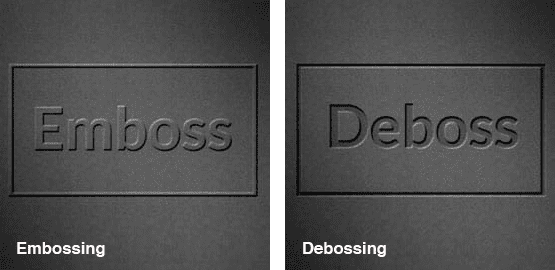Embossing and Debossing Swing Tags
Embossed hang tags are an eye-catching, unique way to promote products, provide information or act as gift tags. Embossing adds a raised area to your swing tags, allowing you to highlight the important elements of your swing ticket.
We also offer debossed hang tags; debossing has the same impressive effect but with an indented design.
Use embossing and debossing to highlight important elements of your custom hang tag, including your logo, name or contact information. Adding embossing or debossing to your swing tags adds a visual contrast to your otherwise flat tag.
Emboss your company logo or deboss your company name to create eye-catching swing tickets.

How is embossing applied?
Your swing tag will be positioned and secured between 2 dies – either metal magnesium or copper. The die that sits under the swing tag will hold the raised design and the counter die (that sits on top of the swing tag) will have a recessed version of the same design. Both dies are then pushed together using both pressure and heat. This causes the paper fibre to be squeezed to create the permanently embossed design.
Types of embossing
Blind Embossing
Blind embossing is used to describe a raised area that is unprinted. It provides an apparent but subtle contrast without the use of any ink or foil. This method can cope with fairly small detail.
Registered Embossing
When embossing is combined with print, foil or spot UV varnish (or a combination of these), it is referred to as “Registered Embossing”. A second embossed area can be added to your swing tags to provide even more contrast.
Combination Embossing
This method is ideal for swing tags with text and/or simple images. The image is printed, foiled or applied in spot UV and the embossing is aligned to the image so that the printed image is stamped out.
Debossing
Debossing of the opposite of embossing. It uses the same process but the metal dies are transposed so that the area is stamped into the tags and forms a recessed (depressed) area.
As with embossing you can have the area plain and unprinted with just the debossed effect, or you can fill the area with ink or foiling.

Things to consider before you start
Artwork
We recommend vector files for this process, they can easily be scaled up or down without loss of quality.
Keep the design simple – Embossing or debossing should be the star of the show so avoid shading and where possible keep to a single colour so that the embossing/debossing isn’t lost in the print. This is especially advisable if you’ll be using combination embossing.
Choosing the embossed/debossed area
The wow factor of the embossing/debossing is maximised when its used sparingly, however it’s a matter of personal choice and should be tailored to the specific item in question.
Choosing the pattern and paper weight
Consider the depth of your embossing or debossing. Deep embossing/debossing isn’t suitable for small areas as the paper will be prone to tearing. If multi-level embossing is required then use the deeper levels in the less intricate areas to minimise any distress to the paper.
Swing tags that require deep embossing/debossing should be printed on a heavier weight paper/card. This will give a deep and detailed image.
Consider the reverse
The embossing or debossing process will move the paper to the other side of the sheet so there will inevitably be a raised or recessed area on the other side of the sheet.
If you have any further questions about embossing or debossing then call us on 023 8087 8037 or email us.